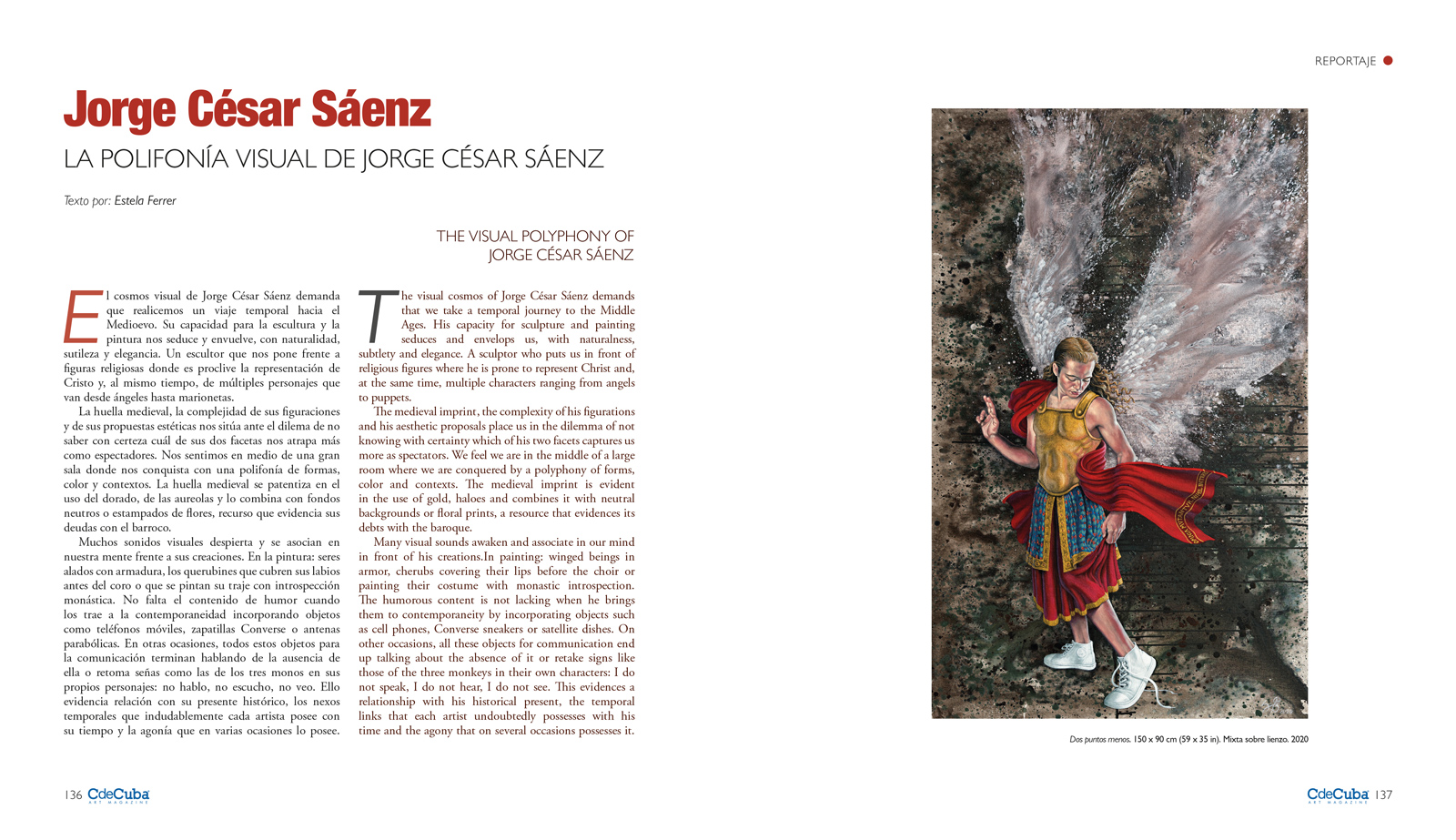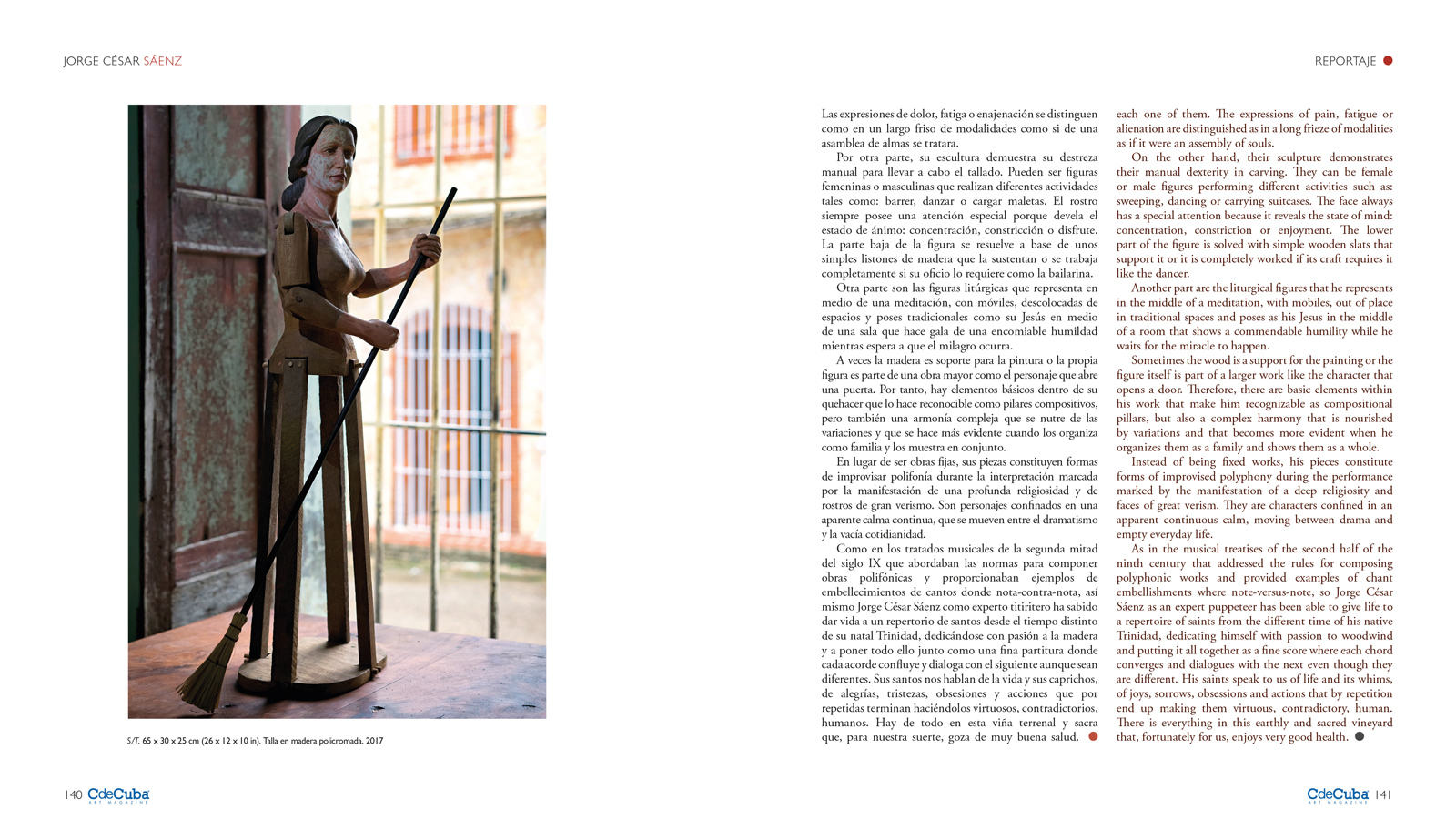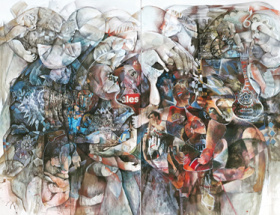The Visual Polyphony of Jorge César Sáenz
By Estela Ferrer
The visual cosmos of Jorge César Sáenz demands that we take a temporal journey to the Middle Ages. His capacity for sculpture and painting seduces and envelops us, with naturalness, subtlety and elegance. A sculptor who puts us in front of religious figures where he is prone to represent Christ and, at the same time, multiple characters ranging from angels to puppets.
The medieval imprint, the complexity of his figurations and his aesthetic proposals place us in the dilemma of not knowing with certainty which of his two facets captures us more as spectators. We feel we are in the middle of a large room where we are conquered by a polyphony of forms, color and contexts. The medieval imprint is evident in the use of gold, haloes and combines it with neutral backgrounds or floral prints, a resource that evidences its debts with the baroque.
Many visual sounds awaken and associate in our mind in front of his creations.In painting: winged beings in armor, cherubs covering their lips before the choir or painting their costume with monastic introspection.The humorous content is not lacking when he brings them to contemporaneity by incorporating objects such as cell phones, Converse sneakers or satellite dishes. On other occasions, all these objects for communication end up talking about the absence of it or retake signs like those of the three monkeys in their own characters: I do not speak, I do not hear, I do not see. This evidences a relationship with his historical present, the temporal links that each artist undoubtedly possesses with his time and the agony that on several occasions possesses it. However, even in these cases there is no aggressiveness in his speech, and the formal quality is evident.
This complex corpus resembles a great musical texture where multiple phenomena coexist at the same time, human times intertwine, the legacies of artistic historiography come together and Sáenz, like an exquisite corpse of Dada or a surrealist artist, summons to his canvases and sculptures the most incredible associations with an extraordinary naturalness. The importance of each work is similar, but the rhythms are diverse. Sometimes calmer, sometimes more agitated and antagonistic. There is not only one form in his content, there are many and his knowledge when applying color is demonstrated in each one of them. The expressions of pain, fatigue or alienation are distinguished as in a long frieze of modalities as if it were an assembly of souls.
On the other hand, their sculpture demonstrates their manual dexterity in carving. They can be female or male figures performing different activities such as: sweeping, dancing or carrying suitcases. The face always has a special attention because it reveals the state of mind: concentration, constriction or enjoyment. The lower part of the figure is solved with simple wooden slats that support it or it is completely worked if its craft requires it like the dancer.
Another part are the liturgical figures that he represents in the middle of a meditation, with mobiles, out of place in traditional spaces and poses as his Jesus in the middle of a room that shows a commendable humility while he waits for the miracle to happen.
Sometimes the wood is a support for the painting or the figure itself is part of a larger work like the character that opens a door. Therefore, there are basic elements within his work that make him recognizable as compositional pillars, but also a complex harmony that is nourished by variations and that becomes more evident when he organizes them as a family and shows them as a whole.
Instead of being fixed works, his pieces constitute forms of improvised polyphony during the performance marked by the manifestation of a deep religiosity and faces of great verism. They are characters confined in an apparent continuous calm, moving between drama and empty everyday life.
As in the musical treatises of the second half of the ninth century that addressed the rules for composing polyphonic works and provided examples of chant embellishments where note-versus-note, so Jorge César Sáenz as an expert puppeteer has been able to give life to a repertoire of saints from the different time of his native Trinidad, dedicating himself with passion to woodwind and putting it all together as a fine score where each chord converges and dialogues with the next even though they are different. His saints speak to us of life and its whims, of joys, sorrows, obsessions and actions that by repetition end up making them virtuous, contradictory, human. There is everything in this earthly and sacred vineyard that, fortunately for us, enjoys very good health.






